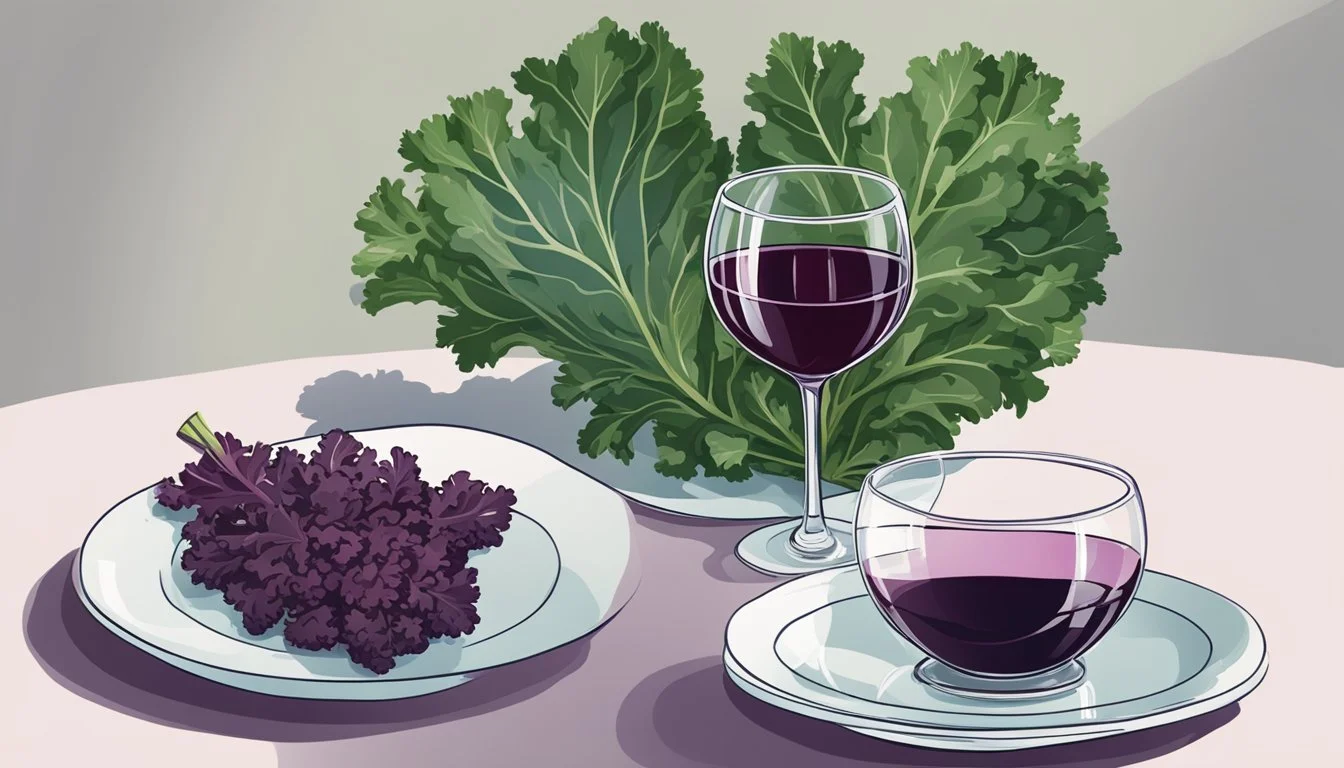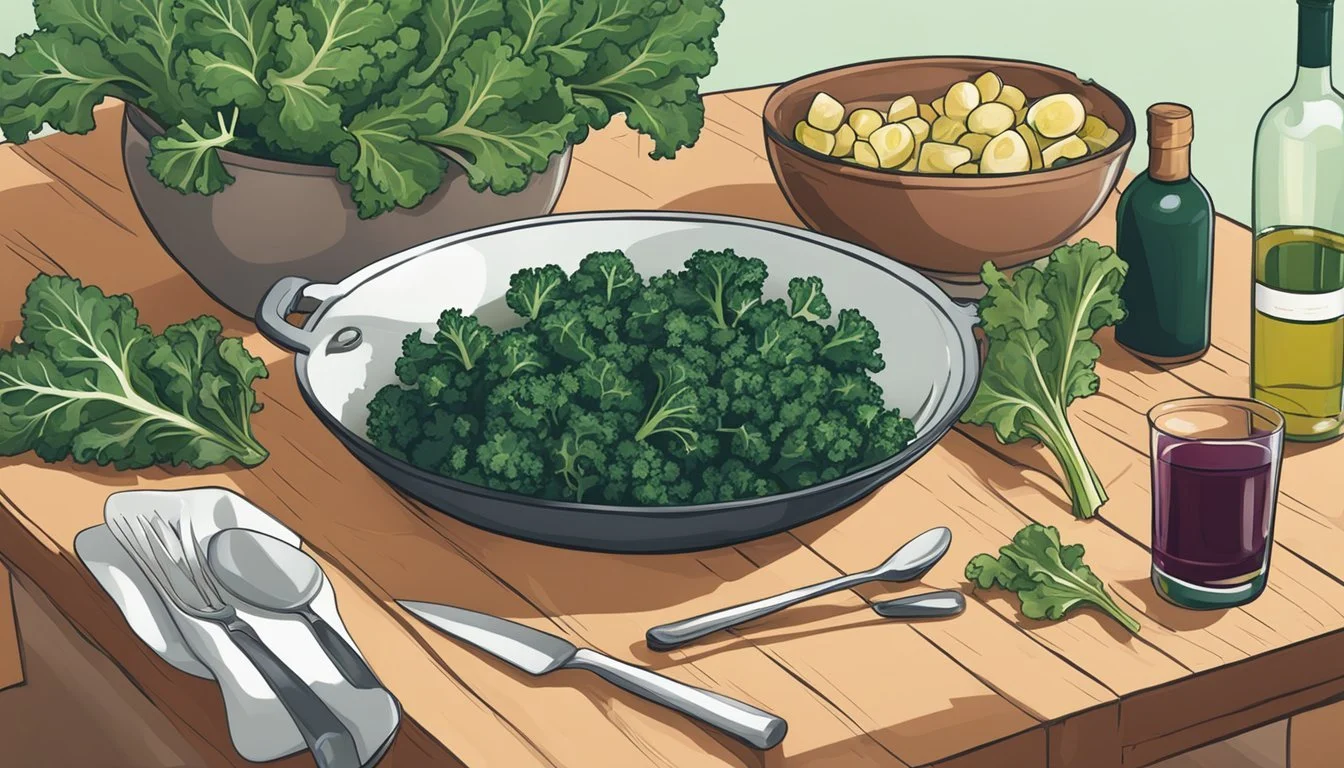What Wine Goes Well with Kale?
Pairing Tips for the Perfect Match
Pairing wine with kale can elevate a simple leafy dish to a noteworthy culinary experience. Kale, a versatile and nutrient-rich member of the cabbage family, offers a distinctive earthy flavor with a slightly bitter undertone. Whether served in a salad, sautéed, or incorporated into a more complex dish, kale has a robust presence on the palate. Choosing the right wine to accompany kale involves considering the bitterness of the green and the cooking method used to prepare it.
Several wines can complement kale's unique flavor profile. When dealing with raw kale salads, which can have a more pronounced bitter edge, wines high in acidity like a bright Grenache rosé are often chosen to balance the bitterness. They introduce a complementary flavor dynamic with their fruity notes and crispness. Conversely, lacinato kale, known for its deeper hue and somewhat sweeter taste, allows for a broader range of wine pairings.
For cooked kale dishes, such as those that blend the greens into creamy pastas or stews, the options diversify further. A good Italian white wine like Gavi provides a refreshing contrast with its crisp minerality, enhancing the creamy textures and rich flavors of dishes featuring the hearty green. The pairing process truly depends on the specific preparation and seasoning of the kale, as well as one's personal wine preference. Wines like Grüner Veltliner, known for their apple notes, and slightly oaked white wines, can also be considered when the kale is part of a more complex flavor composition.
Understanding Kale
Kale has solidified its place as a staple in the healthy diets due to its versatility in cooking and high nutritional value. This leafy vegetable comes in a variety of forms, each with its own unique qualities and uses in the kitchen.
Varieties of Kale
Curly Kale: Recognizable by its ruffled leaves and fibrous stalk, curly kale is commonly found in supermarkets. Its hearty texture is suitable for a range of dishes, from salads to stews.
Lacinato Kale: Also known as dinosaur kale or cavolo nero, lacinato kale has a slightly sweeter and more delicate taste. Its long, dark blue-green leaves with an embossed texture make it a favorite for raw dishes.
Cavolo Nero: Translating to "black kale," cavolo nero is often used interchangeably with lacinato kale and stands out for its robust flavor, which is enhanced through cooking.
Cooking with Kale
Kale's adaptability becomes evident when it is prepared in the kitchen:
Raw: Tenderizing raw kale by massaging it softens the leaves, making it a nutritious addition to salads.
Cooked: When lightly sautéed with aromatics such as garlic, kale becomes a flavorful side. It can also be added to soups, broths, and pasta dishes (What wine goes well with pasta dishes?).
Nutritional Value
Kale is highly regarded for its nutritional benefits, which include:
Vitamins: High in vitamins A, C, and K.
Minerals: A good source of calcium and potassium.
Fiber: Contains dietary fiber that supports digestive health.
This green vegetable is both low in calories and dense in nutrients, solidifying it as a healthy choice for a well-balanced diet.
Basics of Wine Pairing
When considering wine pairings, one needs to take into account various factors such as acidity, sweetness, bitterness, and the body of the wine to ensure complementary combinations with foods, especially those with prominent flavors like kale.
The Impact of Acidity on Pairing
Acidity is a critical aspect when pairing wine with food. Acidic wines, such as Sauvignon Blanc or Grüner Veltliner, can complement the natural bitterness of kale by cutting through and balancing its earthy flavors. An acidic wine's crispness can also contrast well with rich, fatty dressings often used in kale salads.
Recommended pairing: Grüner Veltliner with kale salad
Balance of Sweetness and Bitterness
The presence of tannins in wine contributes to its bitter flavor profile. To balance this bitterness, one can pair wines with a hint of sweetness to offset the bitterness of both the wine and the kale. This contrast can enhance the dish as well as the wine.
For kale salads that contain bitter elements: Opt for wines with a slight sweetness or fruity notes.
Importance of Wine Body
The body of a wine, affected by its alcohol content, is the sense of weight or fullness on the palate. Full-bodied wines, often high in alcohol, can overpower delicate flavors in food, while light to medium-bodied wines might be more suited to the subtle, earthy flavors found in kale dishes.
When pairing with hearty kale dishes: Consider the weight of the wine; a rosé with medium body might be an excellent choice.
White Wine and Kale
Kale, with its robust flavors and slight bitterness, pairs well with a variety of white wines. Choosing the right white wine can complement both the taste of the kale and the accompanying ingredients, enhancing the dining experience.
Sauvignon Blanc
Sauvignon Blanc is an excellent match for kale due to its crisp acidity and notes of citrus. It works particularly well when kale is dressed with ingredients like lemon juice or garlic. This white wine's hint of minerality can also enhance the earthiness of the greens.
Riesling
Riesling, an aromatic white wine, can be a delightful pair with kale, especially if the dish contains elements of sweetness or fruit. The wine's natural fruitiness and sweetness contrast nicely with the slight bitterness of kale, balancing out the flavors.
Grüner Veltliner
Grüner Veltliner is known for its peppery note, which complements kale's pungent character. Elements like minerality are particularly pronounced in this wine, making it a suitable choice for dishes that may include kale sautéed with shallots or peas.
Chardonnay
An unoaked Chardonnay, known for its lighter body and emphasis on fruit rather than rich, buttery notes, can pair well with kale. The key is to avoid overpowering the greens, so one should opt for Chardonnays that express a clean and fresh profile with a touch of acidity.
Italian White Varieties
Italian white wines, such as Pinot Grigio or Vermentino, often present a zesty acidity and lightness that can cut through the density of kale dishes. These wines may also feature notes of lemon and minerality, which can bring out the best in simple kale preparations. They are particularly well-suited to kale dishes combined with salty cheeses or Italian seasonings.
Red Wine with Kale
Red wines can offer a robust complement to the hearty texture and strong flavors of kale. They tend to have the tannins and acidity needed to balance kale's bitterness, especially when the vegetable is incorporated into dishes with rich ingredients like beans or grilled chicken.
Pinot Noir
Pinot Noir is a versatile red wine that pairs well with kale due to its balance of fruit flavors and earthy undertones. The high acidity in a Pinot Noir makes it excellent for cutting through the bitterness of kale. When the kale is served with ingredients that have a sweeter profile, such as roasted tomatoes, the subtle fruitiness of Pinot Noir especially shines.
Chianti
Chianti, a medium-bodied wine known for its red and black cherry notes, offers a nice fruity balance to dishes featuring kale. The wine's acidity complements kale's strong flavors, and when coupled with kale-based dishes that include olive oil and Italian seasonings, Chianti brings out the richness of these components without overpowering the greens.
Light-Bodied Red Wines
Kale salads or dishes with a lighter fare are best matched with light-bodied red wines. An Oregon Pinot Gris, though not a red, can be an excellent choice for these types of kale dishes due to its crisp and refreshing acidity. However, when sticking to reds, those with a bright acidic profile, and not too high in tannins, such as a young Gamay or Frappato, complement kale by not overshadowing its natural flavor while providing a pleasant palate cleanse between bites.
Specialty Wine Styles
Exploring specific wine styles can enhance the kale dining experience, with each style bringing its own character to the table.
Rosé and Kale Pairings
Rosé wines, particularly those from the Provence region, are known for their crispness and subtle fruitiness which complements kale's earthy profile. A Grenache Rosé—dry, with red fruit flavors and high acidity—cuts through the bitterness of kale, elevating the flavors of a kale salad.
Sparkling Wines
Sparkling wines add a celebratory touch to any kale dish. Cava and Champagne, for instance, bring an acidic balance that matches well with the green's robust nature. The effervescence of sparkling wines can lighten the meal, with Champagne offering a sophisticated pairing option.
Dessert and Fortified Wines
While not typically associated with greens, a kale dish with added sweetness—such as in a kale and fruit salad—can be paired with certain dessert wines. These wines contribute a complementary sweetness to counterbalance kale's inherent bitterness. For heartier dishes, a fortified wine with more body, such as a lightly sweet Sangria, can also be a delightful pairing.
Non-Wine Alcohol Options
While wine is a classic pairing for kale, there are several non-wine alcoholic options that can complement the flavors of this leafy green. The key is to balance the bitterness of kale with the right type of beer, cider, or spirit.
Beer and Cider Pairings
Beer: When pairing beer with kale, one should opt for brews with a hoppy bitterness that mirrors the vegetable's own bite. An IPA (India Pale Ale) tends to have the necessary bitterness to stand up to kale's strong flavors. Alternatively, a Saison could provide a nice balance with its herbal notes.
Cider: Dry apple cider makes an excellent choice as its crisp tartness can cut through the bitterness of kale. If the kale dish includes elements like fruit or a sweet dressing, a slightly sweeter cider can provide a harmonious match.
Spirits and Cocktails
Spirits: In cocktails, clear spirits such as gin with its botanical nuances can align well with the earthy tones of kale. If kale is being enjoyed in a warm dish with richer flavors, such as one might find in a pasta containing cavolo nero, an aged rum or whiskey could be a satisfying counterpoint, especially in a cocktail format.
Cocktails: A cocktail crafted with fresh vegetable juices, such as carrot or beet, can mimic the hearty profile of kale. The addition of wellness-inspired ingredients like ginger or turmeric in these mixed drinks can also elevate the overall dining experience.
Preparing Kale-Focused Dishes
Preparing dishes with kale can elevate the vegetable to the star of the meal. The right combination of flavors and cooking methods can enhance its taste and texture, offering a delightful experience when paired with the perfect wine.
Salads and Dressings
Kale is often the base ingredient in healthful salads. To prepare these, one should first tear the leaves into bite-sized pieces, and, if raw toughness is a concern, massage them with a bit of olive oil. This not just tenderizes the leaves but also deepens their vibrant color. A popular dressing option is a Dijon vinaigrette, as the tanginess complements kale's slight bitterness. For an indulgent twist, a creamy dressing can be introduced, although this may require a more robust wine to balance the richness.
Dressing Options:
Olive oil with lemon juice
Cream-based dressings
Dijon vinaigrette
Sautéed and Braised Kale
Kale truly shines when it's sautéed or braised, becoming softer and mildly sweet. For sautéing, one should heat extra-virgin olive oil in a pan and cook chopped kale with garlic until it wilts. A splash of white wine can add a delightful acidity and depth. Braising, on the other hand, might include chicken stock or cream to create a richly flavored side dish. These cooking methods help in reducing the innate bitterness of kale.
Sautéed Kale Recipe Steps:
Heat olive oil and garlic.
Add kale and sauté.
Deglaze with a splash of white wine.
Kale as a Side Dish
Kale can be an excellent side dish, whether it's in the form of pesto spread on crostini or integrated into a creamy skillet dish. Preparing kale as a side dish often involves cooking it down until it's tender and can absorb flavors from accompanying ingredients, like aromatic herbs and garlic. One might choose to accentuate the dish with a dollop of dairy, such as cream or cheese, to contrast and soften the kale's vegetal notes.
Side Dish Examples:
Kale pesto crostini
Creamy kale skillet with garlic
Kale's versatility allows it to be a delicious main feature or complement any meal, proving it to be a valuable addition to both casual and sophisticated dishes.
Pairing Tips and Common Questions
When choosing wine to pair with kale, one should consider the dish's preparation method and flavor profile. This section provides insights into selecting the right temperature and glassware, interpreting sommelier recommendations, and adjusting pairings to align with personal taste preferences.
Temperature and Glassware
For white wines like Sancerre and Sauvignon Blanc, which are often praised for their compatibility with kale, serving temperature impacts their aromatic qualities. These wines should be served chilled, between 8°C to 12°C (46°F to 54°F), to enhance their crisp, herbaceous traits. In terms of glassware, using a white wine glass with a slimmer bowl helps concentrate the aromatic and herbaceous characteristics of the wine.
Decoding Sommelier Advice
Sommeliers often recommend wines such as Grüner Veltliner or Arneis for kale dishes, citing their ability to complement the vegetable's earthy tones. A Grüner Veltliner showcases an aromatic profile that aligns well with kale's natural flavors. Arneis, an Italian white, offers a delicate match for dishes incorporating kale, such as creamy pasta sauces. Both varietals share a common trait – their herbaceous notes make them suitable selections for the green, slightly bitter profile of kale.
Adjusting Pairings for Taste Preference
Those aiming for a healthy lifestyle may gravitate toward kale-centric dishes and wish to adapt the wine pairing to their dietary choices. For a lighter option, one might opt for a glass of Sancerre or a dry rosé, which cuts through kale's bitterness while aligning with a health-conscious approach. On the other hand, for those who enjoy richer, more robust flavors, a Sangria blend can provide a fruity counterpoint to balance the hearty nature of kale. The wine choice should ultimately reflect the individual's taste while considering the nuances of the dish.
Global Wine Regions for Pairing
Certain wine regions around the globe are renowned for producing varietals that complement the flavors found in kale dishes. These regions offer wines that can both contrast and enhance the earthy, robust nature of kale.
The Loire Valley and Sauvignon Blanc
The Loire Valley is celebrated for its Sancerre, a wine with vibrant acidity and minerality that it is often made from Sauvignon Blanc grapes. This high acidity is excellent for cutting through the bitterness of kale, making it a suitable match for kale salads or sautéed kale.
Austrian Grüner Veltliner
Austria is home to the Grüner Veltliner grape, creating wines that express crispness and subtle spice notes, complementing the peppery aspects of kale. These wines can be particularly good with kale dishes that include apple or other fruity components.
Italian Pairing Varieties
Italy contributes a variety of wines that pair well with kale:
Gavi: A white wine from the Piedmont region, often made from the Cortese grape, which offers a balance of acidity and fruitiness ideal for creamy kale pasta dishes.
Vermentino: Typically found in coastal regions like Liguria and Sardinia, Vermentino brings a zestiness that can brighten up kale dishes.
Arneis: Another Piedmontese white, Arneis exhibits floral and pear notes that can soften the strong characteristics of kale.
It is through these regional wines that one can find harmony in pairing with the bold profiles of kale.
Enhancing Your Wine Knowledge
When embarking on the journey of pairing wines, such as finding the perfect complement to kale, one must consider factors like acidity and minerality. Knowledgeable sommeliers often stress the importance of these characteristics in wine selection.
Exploring Local Wine Shops
Local wine shops are treasure troves of information and selection. They often employ staff with a strong understanding of wine attributes, including acidity, minerality, and how these play with various foods.
Ask Questions: Don't hesitate to engage with the store's sommeliers or wine experts about which wine varietals have the acidity level to balance kale's bitterness.
Regular Visits: By frequenting these shops, one becomes familiar with seasonal offerings that may enhance the wine-pairing experience.
Tasting Events and Wine Courses
Tasting events offer a hands-on opportunity for learning, allowing one to experience the effects of acidity and minerality firsthand. Some key points to consider:
Wine Courses: Often provided by local wine shops or community colleges, these can deepen one's understanding of wine profiles and how they complement certain foods.
Tasting Events: These gatherings are ideal for learning the nuances of different wine varietals and how they may elevate a dish such as kale.
Building a Versatile Wine Collection
A well-rounded wine collection includes a variety of wines to match with a diverse range of dishes. For greens like kale, consider the following:
Acidity is Key: Select wines that offer a good level of acidity to counterbalance the bitterness of kale.
Diversity: Include wines ranging from crisp, un-oaked whites to aromatic rosés, ensuring a match for every type of kale preparation.
By following these guidelines, anyone can enhance their wine knowledge and confidently select wines that will complement and elevate the taste of kale dishes.
Conclusion
When selecting a wine to accompany a kale dish, acidity is key. High-acid wines like a Grenache Rosé can counterbalance kale's natural bitterness, bringing harmony to the palate. Such rosés, with their red fruit undertones, are especially suited to raw preparations of kale.
Grüner Veltliner, renowned for its apple-like flavors, is another excellent choice. It complements kale salads that feature fruit elements, emphasizing the dish's freshness. Furthermore, un-oaked Italian whites like Gavi shine alongside kale featured in creamy pasta dishes, where their crispness cuts through the richness.
For those enjoying kale with strong accompaniments like chorizo, the wine should match the dominant flavor rather than the kale. In these cases, the rich and tannic properties of a Barbera d'Alba can stand up to heartier ingredients.
Grenache Rosé
Kale Preparation: Raw, salad
Food Pairing Tips: Balances bitterness
Grüner Veltliner
Kale Preparation: Kale with fruit components
Food Pairing Tips: Complements apple notes
Italian Gavi
Kale Preparation: Kale in creamy dishes
Food Pairing Tips: Cuts through creaminess
Barbera d'Alba
Kale Preparation: Kale with strong flavors
Food Pairing Tips: Matches robust ingredients
It is evident that kale, both nutritious and versatile, can be a delicious counterpart to a wide spectrum of wines. The key to a successful pairing is to consider the wine's profile against the kale's preparation and accompanying flavors.












